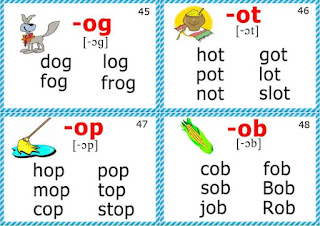
What are Word Families?
If you have spent any time around young learners, be they native speakers or second language learners, you have probably heard of word families. Word families are groups of words that have the same ending sound. Common kindergarten word families are -at, -am, -ad, ag, it, ig, -im, -eg, -op, -ug, -ab, -an, -ut, -id, -ip, and -in. There are more, but these are some of the most common word families when young learners are just starting to read.
People of all ages are naturally drawn to rhymes because of their melodic quality. Thus, rhyming is a fun and engaging way to help children learn to read and write. Rhyming develops phonetic recognition and literacy skills and gives children the tools that they need to read challenging words. Beginning, second language, and struggling readers can use rhymes and word families to help them read difficult words. It is important to remind your students that when two words rhyme, they sound alike. Rhyming words share the same ending sound, as in cat/hat, sun/fun, think/blink, etc.


If appropriate, encourage your students to come up with words that rhyme, it's a lot of fun watching them doing this activity.
To create words, consonants are added to the beginning of the word. For example, m could be added to the -an word family to create the word man. With the exception of a few sight words, these CVC words make up the bulk of beginning words that children learn in kindergarten.

Online Reading Time: 10 Free Reading Websites for Elementary Level Students.
What is a CVC Word?
A CVC word is any word that follows the pattern consonant (C) vowel (V) consonant (C). Here are a few CVC word examples:
man
cat
dog
mop
top
fan
See how each word has a vowel between two consonants? These words are especially easy to sound out because they all have the short vowel sounds and no beginning or ending blends.
READING TIME:Jack and the Beanstalk (Downloadable)
Rhyming words share the same ending sound, and can also belong in the same word family. Review with your students that a word family is a group of words that share the same pattern of vowels and consonants. Vowels are the letters a, e, i, o, u, and sometimes y. Consonants are all the other letters that are not vowels. The words bear and pear belongs in the same word family because they share the ending –ear. In addition, point out to students that words in the same word family are always spelled in similar ways. However, your students should understand that words outside of the word family can still rhyme, such as hair and mare. Some students might recognize that words that are spelled in similar ways may not rhyme, as in hour and four. Present your students with different words and have them brainstorm words in the same family that rhyme and words outside of the family that rhyme.
Native, second language, or struggling readers can use word families to help them to read a challenging or new word. They can look at the challenging word and find words in the same family that they do know how to read. For example, if students have difficulty reading the word blind, they can come up with words in the same family that they do know how to read, such as mind, kind, or find. By giving your students helpful reading strategies, you empower them to become independent readers and successful learners.
Below is a selection of 30 printable worksheets that can be cut into 120 different word family flashcards.
I hope that this article and materials helps you in your classrooms.


















































Thank you for sharing these great activities.
ReplyDelete